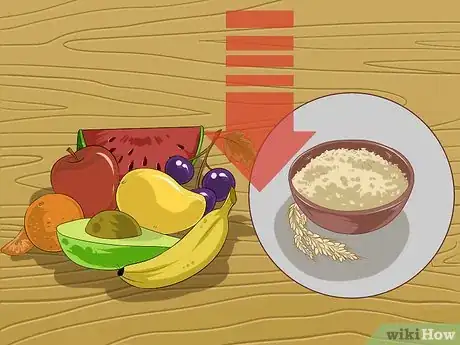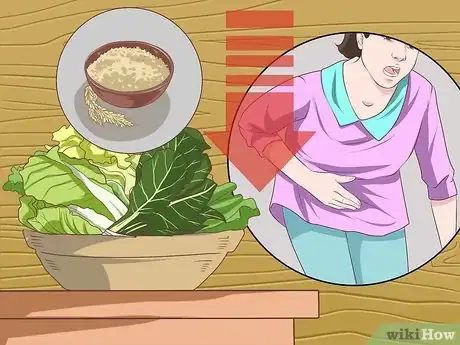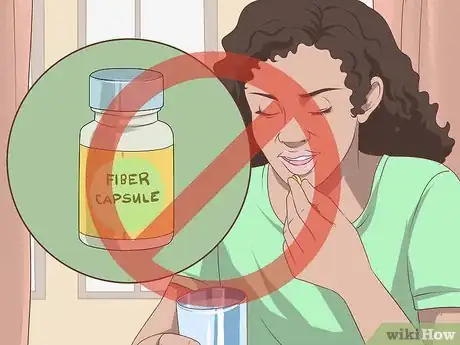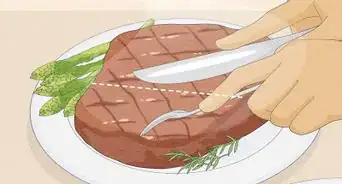This article was co-authored by Claudia Carberry, RD, MS. Claudia Carberry is a Registered Dietitian specializing in kidney transplants and counseling patients for weight loss at the University of Arkansas for Medical Sciences. She is a member of the Arkansas Academy of Nutrition and Dietetics. Claudia received her MS in Nutrition from the University of Tennessee Knoxville in 2010.
There are 7 references cited in this article, which can be found at the bottom of the page.
This article has been viewed 28,407 times.
Fiber is an essential component to a healthy diet. Only found in plant-based foods (like grains, fruits, and vegetables), fiber adds bulk to our meals, allowing your GI system to transport digested food easily. Regular intake of adequate fiber can help prevent constipation and certain cancers like colon or rectal cancer. However, a low-fiber diet may be appropriate for some health conditions like diverticulitis or chronic diarrhea. In addition, some people are sensitive to fiber and too much may cause discomfort and diarrhea. Following a recommended low-fiber diet prescribed by your doctor may help alleviate GI distress and may help you feel better.[1]
Steps
Avoiding High Fiber Foods
-
1Consume less than the recommended amounts of fiber daily. If fiber is affecting your health or making you uncomfortable, it may be ideal to consume less fiber than what's recommended for an average, healthy person.
- The total fiber intake recommended for women is: 25 g daily. The total fiber intake recommended for men is: 38 g daily.[2]
- Keep track of how much fiber you eat throughout the day. You may find it easy to use a food journaling app to help you accurately calculate fiber each day.
-
2Minimize fiber in meals and snacks. Fiber is found in a wide range of foods including grains, fruits, vegetables and legumes. Limiting the fiber in each meal or snack can help cut down on your overall consumption and may alleviate GI symptoms.[3]
- Choose lower fiber fruits or remove fibrous parts of fruits. For example: eat applesauce instead of an apple, because the skin of the apple contains a large amount of fiber, or drink six ounces of 100% juice daily. Fruits that are lower in fiber include: canned fruit, cooked fruit, and fruit without the skin or peel.
- Choose lower fiber vegetables or remove fibrous parts. For example: take the skin off your potato or remove the seeds from your zucchini. Vegetables that are lower in fiber include: canned vegetables, well-cooked and very soft vegetables, vegetables without seeds, and 100% vegetable juice.
- Choose lower fiber grains. For example: avoid 100% whole grain foods since these are higher in fiber. Choose lower fiber grains like: white rice, white bread, cream of wheat or cream of rice, or plain pasta.
Advertisement -
3Limit insoluble fiber. There are two types of fiber — soluble and insoluble. Insoluble fiber is sometimes called "roughage," as it's main function is to speed the process of digestion.[4]
- Insoluble fiber may stimulate bowls more than desired causing diarrhea in those who are susceptible or have a chronic health condition.
- Insoluble fiber is found in the following foods: whole grains, vegetables and wheat bran.
- Soluble fiber absorbs water, makes stools easier to pass and may slow digestion slightly. This type of fiber is more gentle and may be more appropriate for some people.
- Although insoluble fiber may have negative side effects for some, in general, it's a healthy addition to your diet and can help prevent constipation.
-
4Minimize fiber-fortified foods. Many food companies now add fiber into different foods to help increase fiber intake.[5] Fiber may be added to foods that typically have little to no fiber and should be avoided by those minimizing fiber in their diets. Examples of foods to limit include:
- Orange juice with pulp and added fiber.
- Artificial sweeteners with added fiber.
- Yogurts with added fiber.
- Soy milk with added fiber.
- Granola bars or bread that have additional added fiber (these may be lower in fiber prior to processing additional added fiber).
-
5Discontinue fiber supplements. There are a variety of fiber supplements that are available to help people increase their fiber intake. However, these should be discontinued immediately if fiber is posing a problem for you or your health.
- Discontinue the use of any stool softeners or laxatives that contain added fiber.
- Do not take oral gummies or fiber capsules.
- Do not add extra powdered fiber or psyllium husk to foods or beverages.
-
6Write up a meal plan. Writing up a meal plan can help you plan out all the meals and snacks you eat in a day and provide a framework for you to follow throughout the week.[6]
- Calculate how much fiber is in each meal or snack and what your total daily intake will be.
- A meal plan will allow you to change things up, make substitutions or swaps so that you don't go over your target fiber goal each day.
- Take some of your free time to plan your meals and snacks for one week. Include all meals and snacks you typically eat everyday. Repeat this exercise every week or as needed.
Adding Fiber Back to Your Diet
-
1Talk to your doctor. Many times, people follow a low-fiber diet for medical reasons. Always speak to your doctor prior to advancing yourself to a higher fiber diet or resuming your previous high fiber foods.[7]
- Your doctor will most likely give you a specific timeline for reintroducing fibrous foods or give you a certain limitation on your total fiber intake.
- Be sure to ask what types of fiber are appropriate, how you should add fiber back to your diet and what your long-term fiber goal should be.
- Remember that any time you add or subtract large levels of fiber, you are likely to experience gastric changes such as bloating and constipation.
-
2Add fiber slowly. If you've been following a low fiber diet for a while and would like to return to a higher fiber diet, it's important to add in extra fiber slowly.[8]
- A quick increase in extra fiber may cause GI distress and other uncomfortable side effects like: gas, bloating and cramping.
-
3Drink plenty of water. As you increase your fiber intake, it's also extremely important to be consuming adequate fluids as well. Fiber can absorb water and you'll need to drink enough fluids to cover this absorption.[9] As you increase your fiber intake, you must increase your water intake as well.
- The number of ounces of fluids you should drink each day can be found by dividing your weight in half. So if you weigh 200 lbs, you should drink 100 oz of water, or 12.5 glasses of water every day.[10] This will help your digestive system move consistently and help prevent constipation.
- Stick to sugar-free and caffeine-free fluids for your best bet. Water, flavored water, decaf coffee and tea are good options.
Warnings
- Limit fiber intake if you are experiencing GI symptoms or have the recommendation of your doctor. The complete absence of fiber can leave you constipated and may increase the risk of disease.⧼thumbs_response⧽
References
- ↑ https://medlineplus.gov/ency/patientinstructions/000200.htm
- ↑ https://www.eatright.org/food/vitamins-and-supplements/types-of-vitamins-and-nutrients/easy-ways-to-boost-fiber-in-your-daily-diet
- ↑ https://medlineplus.gov/ency/patientinstructions/000200.htm
- ↑ https://health.clevelandclinic.org/whats-the-difference-between-soluble-and-insoluble-fiber/
- ↑ https://www.npr.org/sections/thesalt/2012/02/13/146706553/is-adding-fiber-to-food-really-good-for-your-health
- ↑ https://www.cancer.org/treatment/survivorship-during-and-after-treatment/coping/nutrition/low-fiber-foods.html
- ↑ https://www.cancer.org/treatment/survivorship-during-and-after-treatment/coping/nutrition/low-fiber-foods.html
- ↑ https://www.eatright.org/food/vitamins-and-supplements/types-of-vitamins-and-nutrients/easy-ways-to-boost-fiber-in-your-daily-diet
- ↑ https://www.mskcc.org/experience/patient-support/nutrition-cancer/diet-plans-cancer/low-fiber-diet



































































Medical Disclaimer
The content of this article is not intended to be a substitute for professional medical advice, examination, diagnosis, or treatment. You should always contact your doctor or other qualified healthcare professional before starting, changing, or stopping any kind of health treatment.
Read More...